G1906
Sugar Beet Cyst Nematode
This guide gives more information on sugar beet nematode disease, including symptoms, management, and pathogen lifecycle.
Robert M. Harveson and Tamra A. Jackson
Extension Plant Pathologists
- Introduction
- Symptoms and Signs
- Damage
- Pathogen Life Cycle
- Survival in Soil
- Distribution and Spread
- Host Range
- Management
Introduction
The sugar beet cyst nematode (Heterodera schachtii Schm.) is a major parasite and production problem for sugar beet-growing areas across the world. First discovered near Halle, Germany in 1859 by H. Schacht, it was named and described by A. Schmidt in 1871. The nematode was later determined to be the major cause of “beet weariness,” responsible for the closure of at least 24 sugar beet processing factories in Germany after 1876.
The spread of the sugar beet cyst nematode has historically been associated with expanded sugar beet production in new geographic areas. It was first reported in the U.S. in 1895 from Lehi, Utah, and by 1907 had been identified in California, Colorado, Idaho, and Utah. Interestingly, it was later found infesting the roots of shadscale saltbush (Atriplex confertifolia), collected in the desert foothills west of Utah Lake, Utah in 1927, suggesting another origin for the parasite independent of that from Germany. This plant is drought-tolerant, native to many arid areas of the western U.S., and, like the sugar beet, is also a member of the Chenopodiaceae family.
Sugar beet cyst nematode has been a serious pest in the North Platte Valley of western Nebraska since the 1920s, and was first reported from two fields near Gering in 1926. Now it is present in 17 U.S. states and in 39 other sugar beet-growing countries.
Symptoms and Signs
Fields may be uniformly infested or may have localized areas of infestations. Look for circular to oval spots where poor plant stands and growth are observed (Figure 1). The pathogen can attack plants of any age, and seedlings or young beets may be killed (Figure 2), resulting in reduced stands. Young plants infected by the disease have elongated petioles and remain stunted until harvest. Leaves of severely affected plants additionally wilt and have pronounced yellowing (Figure 3). The most easily recognized sign of infection is the white to pale yellow, lemon-shaped adult females (1/32 inch) attached to roots (Figure 4).
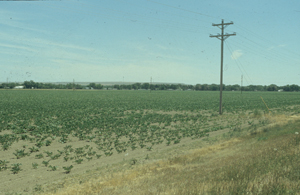 |
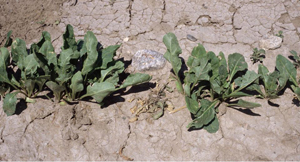 |
|
| Figure 1. Localized areas of nematode infestation resulting in poor sugar beet stands. | Figure 2. Death of young plant from sugar beet cyst nematode. | |
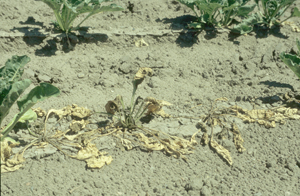 |
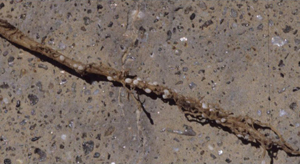 |
|
| Figure 3. Foliar wilting and yellowing. | Figure 4. Lemon-shaped females attached to young tap root early in the season. |
Damage
Tap roots will be reduced in size and produce an excess of storage roots often referred to as being “bearded” or “whiskered.” Such roots may also be confused with those affected by rhizomania (Figure 5). Plants infected early may also be severely branched. When older plants are attacked, symptoms and resulting damage are much less noticeable.
The economic yield loss threshold is approximately two to four nematode eggs in one cubic centimeter of soil. Several factors will lower the threshold, including a higher sugar price, higher percent of sugar, and lower cost of management. Damage is determined primarily by how long favorable environmental conditions will last and the number of nematodes present. Greatest damage to sugar beet crops occurs when a wet spring is followed by a dry summer conducive for the nematode.
In addition to the direct damage caused by sugar beet cyst nematode, the nematodes can also interact with other common pathogens and contribute to greater yield loss caused by their combined diseases. For example, seedling diseases caused by three different species of Pythium and Rhizoctonia solani can be worse when sugar beet cyst nematode is also present in a field. In fact, some interactions are synergistic, meaning that the damage caused by them working together is greater than the additive damage of the nematode and fungal diseases individually. These disease interactions are an additional reason why the disease should be monitored and managed.
Pathogen Life Cycle
Sugar beet cyst nematode is a parasitic roundworm that overwinters in soil as dormant eggs or juveniles in cysts, which is the dead body of the female (Figure 6). When the root of a host plant contacts or grows near the cyst, combined with adequate soil moisture and temperatures above 50°F, the second stage juveniles (J2) are stimulated by root exudates to hatch from their eggs and emerge from cysts. They migrate to roots, infecting near the tips. After entering roots, they migrate deeper into the cortex and begin developing into swollen third stage juveniles (Figure 7). After the fourth molt, females become lemon-shaped and can be seen as small white dots attached to young fibrous roots (Figure 8). Adult males emerge from roots, enter soil and are attracted to females where fertilization occurs.
Females produce an average of 200 eggs each, the majority of which remain inside their bodies. When they die, their body wall thickens and is transformed into a leathery, brown-reddish lemon-shaped cyst, completing the cycle. The life cycle normally takes four to six weeks, depending upon soil temperatures. Sugar beet cyst nametode reproduces optimally between 70° to 80°F, and is capable of producing three cycles in a season in western Nebraska.
 |
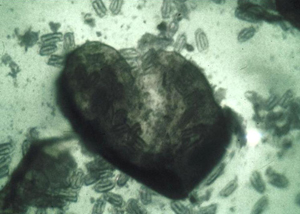 |
|
| Figure 5. Root “bearding” caused by rhizomania, but would also resemble sugar beet cyst nematode damage. | Figure 6. Cyst (dead female) of sugar beet cyst nematode broken open to reveal eggs. | |
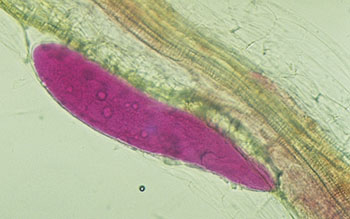 |
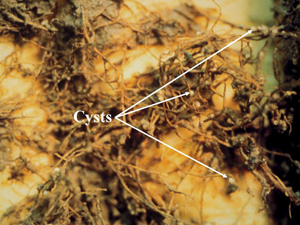 |
|
| Figure 7. Swollen third stage juvenile breaks outside the root with head still embedded for feeding (stained with acid fuchsin). | Figure 8. Lemon-shaped females (cysts) attached to fibrous roots late in the season. |
Survival in Soil
Cysts, which contain eggs and/or juveniles, can remain viable in irrigated fields for several years. Rates of decline each year of populations in soils during rotations range from 40 percent to 60 percent, but they can survive for longer periods of time in fallowed soil. Survival and rate of decline is influenced by soil type, temperature and moisture, crop susceptibility, and number of nematode parasites or predators present. In a traditional western Nebraska sugar beet-corn-dry bean rotation, preplant egg and juvenile populations generally range from 0 to 15 per ml of soil, and higher population densities are often found in shorter rotations.
Distribution and Spread
Although cysts may be found in the profile up to 24 inches below the soil surface, most are concentrated in the root zone (upper two to ten inches). Long-distance spread of cysts has most likely been accomplished in soil particles in infested seed. Contaminated farm equipment, animal hooves and other soil-moving methods can also aid in long distance dispersal. Short distance movement may also occur through irrigation water, bird or other animal feces, or in wind-blown soil. At harvest, cysts are attached to roots and can be shaken off during the unloading process at beet dumps. These tare soils may have more than 100 times greater egg populations than soils collected from infested fields, and thus easily contaminate returning trucks and locations where tare soils may be disposed (Figure 9).
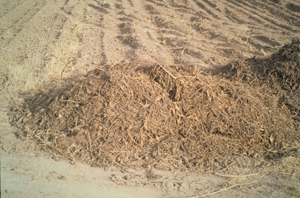 |
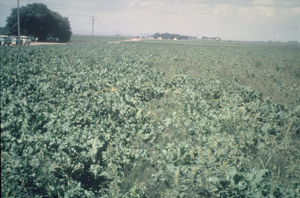 |
|
| Figure 9. Tare soils piled in fields after harvest. | Figure 10. Beneficial effects of fumigation. Note the excellent growth (left) of fumigated area compared to the poor plant growth (right) in the non-fumigated area. |
Host Range
In western Nebraska, sugar beet cyst nematode presently causes economic losses only in sugar beets but it can infect more than 200 plant species in 23 different families. Most susceptible hosts for the nematode are found in the Chenopodiaceae and Cruciferae families.
Management
- Sanitation: tare soils should not be dumped back into fields, as this can result in nematode hot spots. Tare soils could be spread evenly over a harvested field and rotated out of beets for three to five years, or used as fill for washes, bar ditches, etc.
- Rotation with non-host crops: planting crops like small grains, corn, some beans or alfalfa will reduce soil populations through natural decline. However, manage weed hosts to effectively manage the nematode. The length of time for rotating out of beets can be estimated with an expected 50 percent annual decline rate after field populations have been determined.
- Early planting: planting early when soil temperatures are less than 60°F will reduce disease damage. The older plants are when infection occurs, the less the damage and yield loss are realized.
- Trap crops: oil radish and yellow mustard (Cruciferae) crops have been developed and used successfully in Germany. These crops trigger eggs to hatch and infect, but they fail to develop into adults and do not reproduce. Specific varieties of these crops have been developed for the sugar beet cyst nematode, but will have little effect upon the false root-knot nematode. Growers should be aware of the presence of mixed populations of these parasites when choosing management methods.
- Resistant cultivars: there are now several new cultivars available to Nebraska growers with disease tolerance.
- Nematicides can effectively minimize damage caused by sugar beet cyst nematodes under some field conditions, but can be cost-prohibitive and are usually very toxic for the handlers and applicators using them. Nematicides approved for use in Nebraska on sugar beet for management of cyst nematode are listed in Table I.
- Integrated Management: combining several of the previously listed methods will further improve management of the pathogen. Using non-host crops, managing weeds, and planting a trap crop will reduce soil population densities of the nematode. Analyzing soils for pathogen density will help to determine periods when sugar beets may be planted safely or whether a nematicide treatment is warranted (Figure 10).
| Table I. Nematicides labeled for use in Nebraska for management of sugar beet cyst nematode.a | ||||||
Product |
Manufacturer |
Active Ingredient |
Formulation |
Rate |
Re-entry
Interval (REI) |
Application |
| Chloro-o-pic® | Great Lakes Chemical Corp. | Chloropicrin (99%) | Liquid fumigant | 150-500 lbs. per acre | 2 days |
Chiseled in 6-8” deep at least 14 days prior to planting |
| Counter® 15G
Lock’n Load® |
AMVAC | Terbufos (15%) | Granule | 8 oz. per 1,000 ft. or up to 13.1 lbs. per acre | 2 or 3 daysb |
Knifed-in granules at planting 2” to the side of seed and 2-4” below seed |
| Counter® 15G Smartbox® |
||||||
| Ecozin® Plus | AMVAC | Azadirachtin (1.2%) | Liquid | 25.0-56.0 oz./acre | 4 hours |
Foliar spray, chemigation, drench |
| K-Pam® | AMVAC | Potassium N-methyldithiocarbamate (54%) | Liquid fumigant | 30-60 gallons/acre | 2 days |
Inject 6-14” deep 14-21 days prior to planting |
| Sectagon 42® | Tessenderlo Kerley, Inc | Sodium methyldithiocarbamate (anhydrous) (42.2%) | Liquid fumigant | Injection: 15-75 gal/acre
Chemigation: 37.5-75 gal/acre Drench: 25-75 gal/acre |
2 days |
Injection at > 4” deep, chemigation, or drench ≥ 2” deep at 14-45 days prior to planting |
| Telone® C-17 | Dow AgroSciences | 1,3-dichloropropene (81.2%) chloropicrin (16.5%) | Liquid fumigant | Up to 21.6 gallons/acre | Up to 5 daysc |
Broadcast liquid fumigant for preplant |
| Telone® C-35 | 1,3-dichloropropene (63.4%) chloropicrin (34.7%) | Up to 26 gallons/acre | ||||
| Telone® II | 1,3-dichloropropene (97.5%) chloropicrin (2.5%) | Up to 18 gallons/acre | ||||
| Temik® 15G | Bayer CropScience | Aldicarb (15%) | Granule | 27-33 lbs. per acre | 2 days |
At planting or ≤ 1 week prior to planting in a 4-6” band at covered 2-4” deepd |
| aSome of the products listed here are Restricted Use Pesticides (RUPs) due to their acute toxicity and represent the best information available. Read and follow all label directions.
bREI is increased to 3 days in outdoor areas where average rainfall is less than 25 inches per year. cREI varies by specific activity. dAdditional water restrictions and use in certain soil types exist. |
||||||
Disclaimer Reference to commercial products or trade names is made with the understanding that no discrimination is intended of those not mentioned and no endorsement by University of Nebraska–Lincoln Extension is implied for those mentioned. |
This publication has been peer reviewed.
Visit the University of Nebraska–Lincoln Extension Publications Web site for more publications.
Index: Plant Diseases
Sugar Beet
Issued December 2008